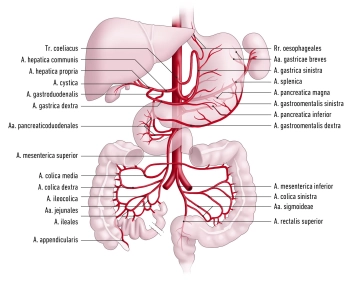Main branches | Course | Branches and their course | Distribution |
Splenic artery | - Along superior margin of pancreas
- Enters the splenorenal ligament and spleen
| Pancreatic branches: Dorsal pancreatic artery: - Posterior to pancreas
- Anastomoses with greater pancreatic artery and continues as inferior pancreatic artery
Greater pancreatic artery: - Caudad along the posterior aspect of tail of pancreas
- Anastomosis at pancreatic tail with dorsal pancreatic artery and inferior pancreatic artery
| Pancreas |
| | Posterior gastric artery: - Runs craniad in phrenicosplenic ligament to gastric fundus
| Stomach (posterior aspect of fundus) |
| | Short gastric arteries: - Course in gastrosplenic ligament to gastric fundus
| Stomach (fundus and greater curvature) |
| | Left gastro-omental artery: - Courses in gastrocolic ligament to greater curvature
- Anastomosis with right gastro-omental artery
| Stomach (fundus and greater curvature) |
Left gastric artery | - Runs to lesser curvature of stomach
- Anastomosis with right gastric artery
| Direct branches | Stomach (lesser curvature) |
| | Esophageal branches | Esophagus |
Common hepatic artery | - Runs right to hepatic portal
- Divides into proper hepatic artery and gastroduodenal artery
| Proper hepatic artery - Main branch of common hepatic artery
- Arises posterior to pylorus
- Runs in hepatoduodenal ligament together with hepatic portal vein and common bile duct to hepatic portal
- Gives rise to three branches:
| |
| | 1. Right gastric artery: - Runs in lesser omentum to lesser curvature of stomach
- Anastomosis with left gastric artery
| Stomach (right lesser curvature) |
| | 2. Right hepatic artery | Liver (right half) Gallbladder (cystic artery) Part of caudate lobe |
| | 3. Left hepatic artery | Liver (left half) Part of caudate lobe |
| | Gastroduodenal artery - Courses posterior to lesser omentum to pancreas
- Divides into 2 branches:
| |
| | 1. Right gastro-omental artery: - Runs to greater curvature
- Anastomosis with left gastro-omental artery
| Pancreas, duodenum, stomach |
| | 2. Anterior and posterior superior pancreaticoduodenal arteries: - Form a vascular plexus around the pancreatic head with branches of the inferior pancreaticoduodenal artery
| |

